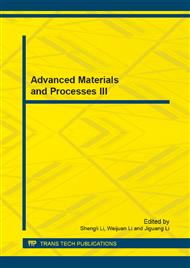p.104
p.116
p.121
p.125
p.133
p.138
p.144
p.149
p.154
Effect of Content and Layer Thickness on the Corona-Resistance of PI/TiO2 Nanocomposite Films
Abstract:
Polymer/TiO2 nanocomposite films have good mechanical, electrical and thermal property, which are applied to electrical engineering and microelectronic technique field extensively. Nano-TiO2 has bigger permittivity and better absorption ultraviolet. The PI/TiO2-PI-PI/TiO2 three layer composite films (30mm) with different content and interlayer thickness were prepared via in-situ dispersion polymerization in this paper. And the films with A (5mm), B (10mm) and C (15mm) interlayer PI thickness are divided into three different series. The results show that inorganic TiO2 nanoparticles are well dispersed in the polymer matrices. And the structures of three layers are obvious. The doped nanoparticles don’t affect the imidization of PI matrix in composite films. The time-to-breakdown of all series films increases with the TiO2 content increasing, in which the B series films possess the best performance. Besides, the B series films with 4% doping content are tested with the longest time-to-breakdown, which is three times more than that of pure PI. After corona aging, there are lots of TiO2-particles with the ability of absorbing UV accumulated on the surface of films, playing the role in shielding electric field, which is one factor resulting in improvement of corona-resistance in the composite films.
Info:
Periodical:
Pages:
133-137
Citation:
Online since:
September 2013
Authors:
Keywords:
Price:
Сopyright:
© 2013 Trans Tech Publications Ltd. All Rights Reserved
Share:
Citation:


